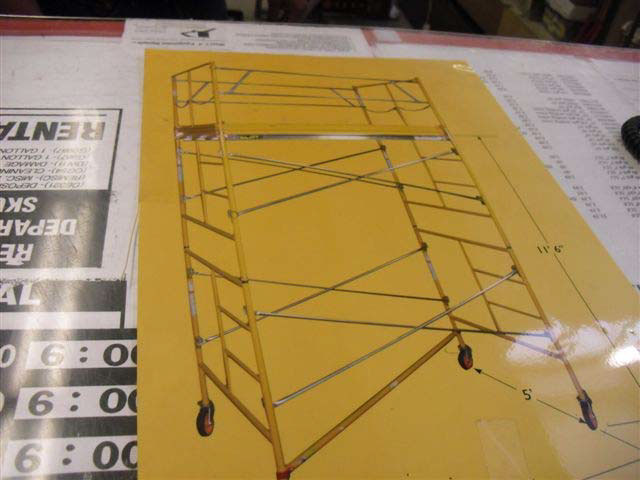Case Report: 11CA002
Day laborer dies when he falls off a scaffold
Download a PDF to print this report:
Day laborer dies when he falls off a scaffold (11CA002, PDF)
Summary
A day laborer fell approximately 12 feet off a scaffold at a private residence. The victim was applying a stone and stucco façade to the exterior of the home when the incident occurred. The victim was hired by the homeowner's gardener from a street corner to perform the work. The victim rented, assembled, and was working from the scaffold when the incident occurred. The scaffold was erected without guardrails and the walk board was not secured. The victim was not wearing any type of fall protection. The CA/FACE investigator determined that in order to prevent future incidents, employers (including homeowners) who hire day laborers that use scaffolds should:
- Ensure they receive training and are competent in the use of scaffolds and fall protection.
Introduction
On Wednesday, January 12, 2011, at approximately 3:00 p.m., a 40-year-old Hispanic day laborer who worked as a construction worker died when he fell from a scaffold approximately 12 feet to the ground below. The CA/FACE investigator received notification of this incident on January 13, 2011, from the Los Angeles District Office of the Division of Occupational Safety and Health (Cal/OSHA). On January 19, 2011, the CA/FACE investigator visited the site of the incident, and interviewed the homeowner, the victim's brother and sister, and the scaffolding rental store agent. The gardener who had hired the victim refused to be interviewed, but the gardener’s son who was familiar with some of the facts surrounding the case was interviewed.
The victim was a day laborer who worked as a construction worker. He was born in Mexico and completed nine years of education. The victim spoke only Spanish. The gardener who hired him also spoke Spanish, but the homeowner did not. The victim had worked in the Los Angeles area for the past five years. There was no documentation available to determine the victim's experience or training in masonry. There was also no documentation available to determine the victim’s qualifications, training, or experience working with scaffolds.
Investigation
The site of the incident was a private residence. The home owner had asked his gardener if he knew anyone who could reface the exterior of his home with a stone and stucco facade. The gardener hired the victim from a street corner to perform the work. The victim rented a scaffold from a local home improvement store and used it to access the exterior of the house. The victim rented five-foot scaffold frame sections, diagonal braces (two for each section), a walk board, and a side and end panel that were to be used as guard rails on the top section of the scaffold.
The victim erected the scaffold but it was leveled using improper methods. The walk board was not properly secured, and the guard rails on the top portion were not attached. He then used the scaffold to gain access to the upper portions of the home's exterior wall. The victim was working alone off the scaffold walk board, approximately 12 feet above ground level and was not wearing any fall protection devices. The victim worked for two days performing the job. On the third day, he continued applying the stucco and stone façade. At one point, the victim reached for a cell phone that was being handed to him by the homeowner’s gardener. The walk board shifted and he fell off the scaffold to the ground below. The homeowner's gardener immediately came to his assistance and called 911. Paramedics responded within minutes and treated the victim and then transported him to a local hospital where he died from his injuries.
Cause of Death
The cause of death according to the death certificate was head trauma.
Recommendations
Employers (including homeowners) who hire day laborers that use scaffolds should:
Recommendation #1: Ensure they receive training and are competent in the use of scaffolds and fall protection.
Discussion: The homeowner asked his gardener if he knew anyone who could install stucco and masonry to the side of his house. The gardener then hired a day laborer (the victim) off the street to perform the actual work. The victim was working on a scaffold that elevated him more than 7 ½ feet above the ground. The victim rented guard rails (according to the receipt) but he never installed them when he erected the scaffold at the incident scene. The victim did not have a personal fall arrest or personal fall restraint system. There was no documentation available to determine the victim’s qualifications, experience, or ability to comprehend all the requirements that were required to do this type of work safely.
Day laborers are workers who meet at well-known locations, usually public street corners or commercial parking lots, and wait for building contractors, landscapers, home owners, and other potential employers to offer work. Day laborers include undocumented immigrants from Mexico and Central America who are unable to gain formal employment because of their legal status. Day laborers are often willing to work regardless of potential hazards that may be present on the job site and may not be aware of or able to notify their employers if they are concerned about their working conditions. Most day laborers have received little, if any, safety training in the work they are hired to perform.
Employers, including homeowners, who hire day laborers to perform hazardous work must provide a safe and healthy work environment and ensure that they are capable of understanding and performing all of the safety aspects related to their work. Organizations that offer workplace safety training to day laborers include the Construction Safety Council (CSC), La Raza Centro Legal Program in San Francisco, the City of Los Angeles Day Laborer Centers, Instituto de Educación Popular del Sur de California (IDEPSCA), and the National Day Laborer Organizing Network (NDLON). Day laborers who have undergone such training are more likely to be familiar with and implement safe work practices. Likewise, homeowners who use licensed contractors for the specific type of work to be performed are more likely to be assured that employees are trained in and familiar with safe work practices.
In this incident the unstable walking board, lack of guardrails and fall protection allowed the victim to fall off the scaffold to the ground below. In California, workers who are elevated more than 7 ½ feet off the ground are required to use fall protection. In this case the use of guard rails would have been adequate fall protection. In lieu of guard rails, the victim should have worn a personal fall arrest or personal fall restraint system. In either case, the use of fall protection would have prevented this incident from occurring. Had the victim been properly trained and made aware of the safety hazards associated with the job, he might have assembled the scaffold correctly and secured the walk board, installed guard rails, or worn a personal fall arrest or restraint system.
Exhibits

Exhibit 1. The stone and stucco work at the incident site.

Exhibit 2. A schematic of the scaffold involved in the incident.
References
California Code of Regulations, Subchapter 4. Construction Safety Orders
Article 21. Scaffolds--General Requirements §1637. General Requirements
Article 22. Scaffolds--Various Types § 1644 Metal Scaffolds
Article 24. Fall Protection. §1670. Personal Fall Arrest Systems, Personal Fall Restraint
Systems and Positioning Devices.
On the Corner: Day Labor in the United States - Latino Union of Chicago (via Foundation Center website)
Authors
Hank Cierpich, FACE Investigator
Robert Harrison, MD, MPH, FACE Project Officer
Laura Styles, MPH, Research Scientist
January 5, 2012